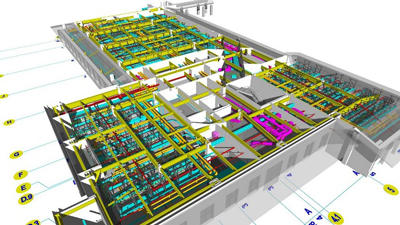Why are MEP BIM Coordination Services Non-Negotiable in Shopping Mall Construction?

Strong 8k brings an ultra-HD IPTV experience to your living room and your pocket.
Introduction
Shopping centers are rushful and complex structures where design and function need to work together. Every portion of the space contains systems (air conditioning, power, water, safety routes, etc.) These systems operate behind walls, above ceilings, and below floors, removed from the sight of the shopper yet necessary to allow the mall to function. Even the smallest misplacement of a pipe, wire, or duct could lead to significant problems and a different use of the space. This is why MEP BIM Coordination Services are so essential; they not only assist with the overall layout of the structures, but also make sure that all the systems come together, work properly, and don't clash. HVAC systems, lighting, and plumbing all need to be planned out very early on, without interfering with the architectural aspects of the building design.
In this blog, we will demonstrate the value of MEP Coordination Drawings and Design Services to ensure shopping malls are built for performance and reliability from start to finish in a seamless way.
The Core of MEP Planning in Shopping Mall
A. Nature of MEP Complexity
Shopping malls operate as self-contained urban ecosystems. A continuous circulation of energy, air, water, and waste runs through every floor, corridor, ceiling, and service zone. Lighting grids, HVAC zoning, fire safety networks, water pipelines, and security systems interweave inside a unified architectural envelope. Without structured coordination, these systems often intersect in conflict.
B. Impact of Mechanical, Electrical, and Plumbing on Building Performance
Mechanical systems determine indoor air movement and cooling. Electrical layouts establish power continuity and lighting functionality. Plumbing grids influence washroom provisioning, drainage, and internal flow management. Combined, these components shape the user environment. Their arrangement does not happen in isolation; they interact constantly, vertically and horizontally.
C. Structural and Space Limitation
Escalators, atriums, underground parking, food courts, and utility corridors add density to mall geometry. Within that tight geometry, even a minor misplacement of ducts or panels affects wall structures, ceiling heights, and spatial functionality. The space within ceilings and risers never expands. All design activity competes within a finite volume.
What Role Does MEP BIM Coordination Services Have?
A. Coordination Before Construction
Mechanical, electrical, and plumbing modeling begins before any equipment selection or duct sizing. MEP BIM Coordination Services initiate this preemptive arrangement. Multiple disciplines converge into a shared virtual environment where modeling reveals physical overlaps, spatial blockages, and inconsistent routing proposals.
B. Avoidance of Onsite Conflicts
All core conflicts surface in this virtual environment. This means no real-world intervention has to occur to detect these discrepancies. Construction sequencing continues unbroken, and rework does not surface.
C. Informed Adjustments Through Simulation
MEP Coordination Design Services allow HVAC technicians, fire protection engineers, and lighting planners to test system behavior within actual space layouts. Adjustments do not occur by guess. Pipe slopes, cable tray bends, duct spacing, and access panels receive consideration at the drawing stage.
D. Holistic System Integration
Unlike fragmented discipline-specific drawings, MEP Coordination Drawings unite system information in a shared environment. The interaction between exhaust lines and lighting coves, or between sprinkler heads and bulkhead frames, becomes visible. Nothing hides behind 2D linework.
Organizational Benefits of Coordination in Malls
A. Regulation Compliance and Routing Accuracy
Every floor plate contains retail zones, public corridors, and service passages. MEP BIM Coordination Services organize all pipes, wires, and vents into well-demarcated routes that do not crisscross or compete for placement. Zones follow logic based on use, not just availability.
B. Optimization of Ceiling and Shaft Space
Shopping malls prioritize visual appeal and spatial fluidity. Mechanical networks cannot intrude into visible ceiling areas. MEP Coordination Drafting Services help maintain this priority by allocating mechanical components into non-visual territories. Without rerouting, the visual intent of design does not shift.
C. Flexibility for Future Expansion
Malls often introduce new tenants, new kiosks, or altered foot traffic flows. When MEP Coordination Outsourcing Services prepare layouts with foresight, rerouting becomes a non-disruptive activity. All system runs retain adaptability.
D. Reduced RFIs and Queries from Site Teams
When drawings depict the full picture—spatial relationships, connection points, mounting clearances—onsite workers do not generate repetitive inquiries. The number of field requests drops significantly, enabling uninterrupted progression.
Practical Application
A. HVAC Layout and Equipment Access
HVAC zones in shopping malls contain various air handling units, VAV boxes, and duct branches. These units require maintenance space, access points, and no physical barriers. MEP Coordination Design Services assist in pre-positioning equipment in zones that respect air movement and access patterns.
B. Electrical Distribution and Panel Positioning
Electrical supply rooms, backup generators, and floor-wise power panels must coexist with other systems. Cable trays and conduits must avoid risers, beams, or HVAC trunks. MEP Coordination Drawings define exact tray heights, offset distances, and clearance zones.
C. Plumbing Network and Drainage Gradient Management
Water supply piping does not run in isolation. It interacts with HVAC condensation lines, sewage drains, and roof rainwater outlets. Gradient management becomes critical, especially in basement areas. MEP Coordination Drafting Services evaluate slope planning in constrained slab zones.
D. Fire Safety and Sprinkler Layouts
Sprinkler heads, smoke detectors, and alarm systems operate in synchrony. Their locations intersect with ceiling design, HVAC outlets, and light fixtures. Proper coordination prevents clashes and maintains spacing as required under safety codes.
Risk Prevention in Time and Scope
A. Avoidance of Delays from Design Discrepancies
Every minor mismatch—be it pipe clash or cable obstruction—generates delay. Redesign requests enter the process, followed by waiting periods. MEP BIM Coordination Services prevent those mismatches from appearing in the first place.
B. Prevention of Redundant Procurement
When two systems claim the same route, equipment sizing changes, or reorders occur. MEP Coordination Outsourcing Services prevent dual ordering, avoiding unusable equipment stockpiles.
C. Continuity in Subcontractor Work Packages
Subcontractors plan activity in blocks—floor wise, zone wise, system wise. If a segment awaits revision, that entire block halts. Clear MEP Coordination Drawings eliminate idle phases and maintain subcontractor timelines.
D. Timeline Transparency for Mall Stakeholders
Retail leasing depends on delivery timelines. MEP Coordination Design Services allow developers to commit to launch dates based on known completion paths. Occupancy goals do not float unpredictably.
VI. Design Outcomes and Spatial Clarity
A. Realistic Space Usage
Mechanical runs receive placement based on real architectural context. There are no abstract guesses. MEP BIM Coordination Services allow direct observation of layout feasibility.
B. Compact Equipment Grouping
Switchboards, control panels, booster pumps, and BMS cabinets can cluster into one mechanical hub per floor. MEP Coordination Drafting Services support this grouping for the economy of space.
C. Clearances and Access Planning
Every unit—electrical or mechanical—requires safe operating access. Coordination models keep surrounding systems out of these zones. Maintainers work without removing other parts.
D. Functional Aesthetic Integration
Designers often use ceilings as visual highlights. MEP Coordination Outsourcing Services preserve this by hiding functional elements within spatial logic—never breaking the visual theme with exposed ducts or fixtures.
Business Gains from Early Coordination
A. Faster Occupancy Turnaround
With MEP Coordination Design Services removing unknowns, developers hand over retail units on known dates. Tenants plan interior fit-outs without delay.
B. Confidence for Investors and Brands
Investor sentiment depends on visible progress. MEP Coordination Drawings show integrated service networks—concrete evidence of planning integrity. Brands signing leases feel confident in timeline visibility.
C. Safety Protocols Embedded from Day One
Exit lighting, emergency shutoffs, and fire suppression get fixed routing early. MEP BIM Coordination Services secure those lifelines within the earliest layout.
D. Energy Use and System Calibration Accuracy
Zoning plans generated through coordination aid in sensor placement, equipment sizing, and runtime management. The building behaves as expected.
Relevance of MEP Coordination Outsourcing Services
A. Access to Specialized Drafting Expertise
Outsourced partners specialize in only one thing—drawing development. MEP Coordination Drafting Services emerge from hands that do nothing else but model real-world behavior.
B. Flexibility Across Time Zones
While architects rest, outsourced teams operate. MEP Coordination Outsourcing Services produce results overnight, compressing review cycles without manual chase-ups.
C. Budget Predictability Without Fluctuation
Engagements run on fixed scopes. Revisions, updates, and change propagation happen without new team hiring. That predictability favors mall developers operating on tight delivery windows.
D. Partnership Scalability with Project Phases
Design phase, tendering, construction supervision—all receive support. MEP Coordination Design Services scale up or down with need. No dependency on fixed internal capacity.
Conclusion
Shopping malls showcase architectural desire, they are massive and aesthetically rich, they provide utility comfort, and they are convenient to visit. This desire changes when service networks are incorporated into the design and construction, or when operations are impaired by an unseen error.
MEP BIM Coordination Services accomplish much more than identifying overlapped drawings. They provide a clear understanding of the invisible structure that lives beneath the public facing wonder. These pieces and other parts fit in the correct place- as designed. Be it the bends in the HVAC, spacing for light fixtures, where fire alarm devices fit, water pipe pitch....each part fits as expected.
As shopping mall developers aim to deliver quality without delays, they will continue to rely on coordination services.
Note: IndiBlogHub features both user-submitted and editorial content. We do not verify third-party contributions. Read our Disclaimer and Privacy Policyfor details.







